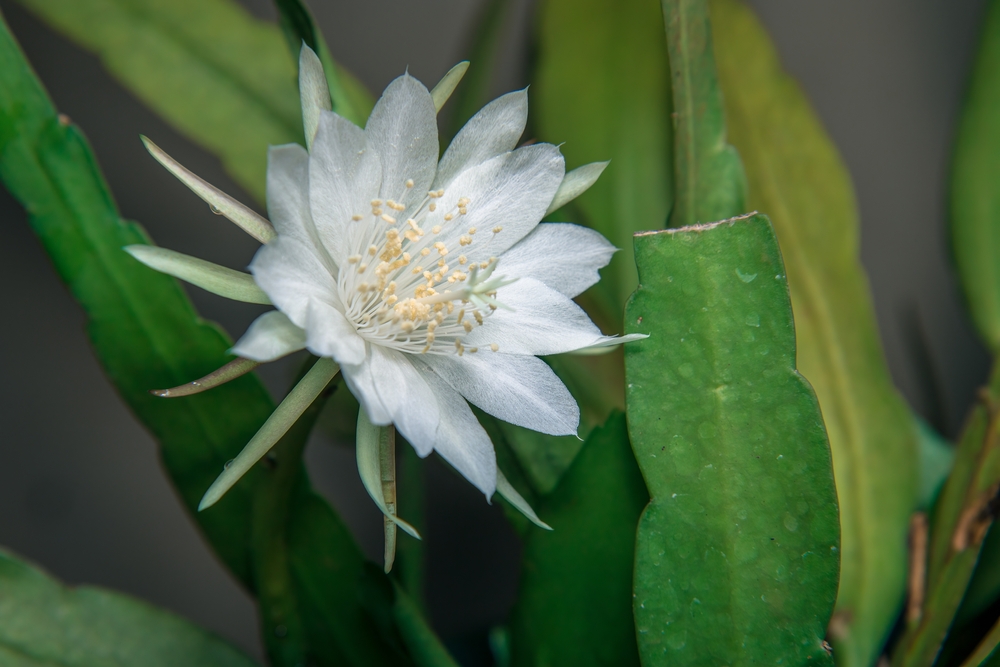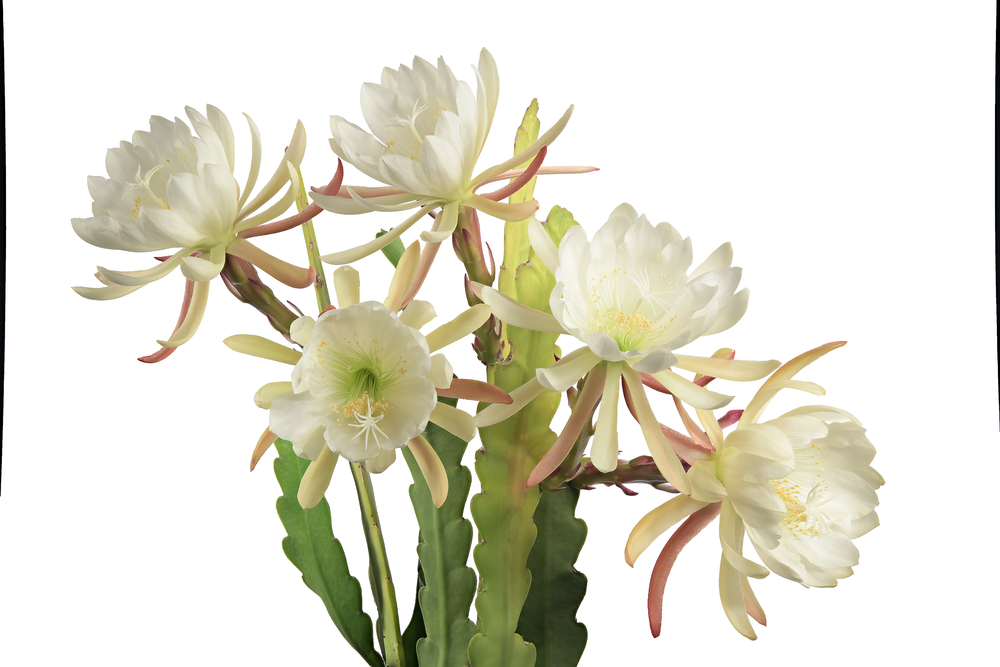One of the most uniquely beautiful plants in the world is the curly orchid cactus. Recognizable by its curling, spiraling leaves that resemble the shape of an orchid flower, this plant is native to rainforests in Central and South America. Its striking appearance, coupled with its easy care requirements, make it a popular choice for both novice and experienced plant enthusiasts alike.
If you’re thinking about adding a curly orchid cactus to your collection, read on for everything you need to know about care and maintenance.

| Botanical Name | Epiphyllum Spp. |
| Common Name | Curly Locks Orchid, Leaf Cactus, Climbing Cacti |
| Plant Type | Perennial |
| Flower Color | White flowers six inches wide |
| Size When Mature | 24 – 120 inches tall |
| Bloom Time | Spring and Summer |
| Sun Requirements | Partial Sun |
| USDA Hardiness Zones | 10 – 12 |
| Soil PH Range | 5.0 – 9.0 |
| Soil Type | Acidic, slightly alkaline, well-draining |
| Water Needs | Medium |
| Native Area | Rainforests of Central and South America |
What You Need to Know About Curly Orchid Cactus
Also called the climbing cacti, this plant lives up to its name by scrambling up trees and other structures in its natural habitat. In the wild, curly orchid cacti can reach lengths up to 10 feet. However, when grown indoors, they are much more manageable and typically only reach heights of 3-6 feet.
Curly orchid locks cacti are epiphytes, which means they grow on other plants or objects rather than in the ground. In their natural habitat, they often grow on tree branches where they receive filtered sunlight. When grown indoors, they can be trained to climb a trellis or totem pole or left to trail off the edge of a pot or planter – and they look good on these!
These plants are relatively slow-growing, but along with that characteristic, this means that their low-maintenance nature carries over to their care requirements.
How to Care for Curly Orchid Cactus
Here’s everything you need to know about growing and caring for a thriving curly orchid cactus:
Light
Although they’re fairly easy to have and take care of, one of the most important things to know about caring for a curly orchid cactus is that they need bright, indirect sunlight. These plants thrive most when they receive dappled sunlight throughout the day.
If decided to grow your cactus as an indoor houseplant, look for a south-facing window and place it there. If you’re growing it outdoors, put it in a spot where it will receive morning sun and afternoon shade.
Never leave your cactus out in direct sunlight for extended periods of time. Partial sun is ideal, and full sun should be avoided.
Water and Soil Needs
Curly orchid locks cactus surprisingly can thrive in a wide range of soil conditions from pH 5.0 – 9.0. However, it’s been observed that when they’re planted in soils on the alkaline side, from 6.2 to 7.0, they show the most growth.
A succulent mix or cactus mix will work perfectly for these plants. Make sure the pot has drainage holes to help excess water escape and prevent your plant from sitting in soggy soil.
Compared to other cacti, curly orchid cacti have higher water needs. During the growing season (spring and summer), water your plant deeply about once a week or when the top 2-3 inches of soil are dry. They’ll need less water during the winter months, so cut back to watering about once every two weeks.
Temperature Requirements
The majority of Epuphyllums can survive 50°F to 60°F, particularly during the growing season. While it’s commonly grown as a houseplant, the curly orchid cactus can also be successfully cultivated outdoors in USDA hardiness zones 10-12.
As per humidity, these plants love humidity as much as it loves filtered sunlight. You can place the pot on a tray of wet gravel – this way, the plant continuously gets humidity from the evaporating water. You may also mist the leaves and stems lightly every once in a while, but make sure not to do this too often as this can lead to fungal growth.
Fertilizer
The best fertilizer to use on a curly orchid cactus is an NPK-balanced fertilizer with a ratio of 10-10-10. Ideally, feeding should be done during the spring and fall. However, you can also dilute the fertilizer to half-strength and feed it during the growing season every other week. This will ensure that your plant gets its nutrients without being overfed.
By the end of winter, around February, you can use a 2-10-10 fertilizer ratio to promote blooming. This will give your plant a boost of phosphorus, which is essential for flower production.
Common Diseases
Many people are drawn to this plant mainly because of its unique appearance. Not only that, they’re relatively free from most pests and common diseases – except for root rot. This is often caused by overwatering, which you can easily remedy by letting the soil dry out completely before watering again.
Root rot affects the plant’s roots, making them soggy, and discolored and eventually leading to the death of the plant. If you think your plant may be affected by root rot, it’s best to take it out of the pot and check the roots. A black or mushy appearance on the plant’s roots is an indication that it’s suffering from root rot.
If you catch the disease early, you may be able to save your plant by carefully removing the affected roots and replanting it in fresh, dry soil. However, if the root rot has spread too far, it’s best to start over with a new plant.
Curly Orchid Cactus Propagation
If you want to propagate your curly orchid cactus, whether to share with friends or to fill your home with its slender leaves that curl and twist in a never-ending dance, propagating by stem cuttings is the best way to do it.
Simply take a stem cutting that contains at least two nodes (the small bumps where leaves emerge). You can plant this on soil or water, depending on what’s available and what you’re more comfortable with. After cutting some stems, leave it to callous for a couple of days.
If planting in soil, use a cactus or succulent mix and plant the cutting about an inch deep. Be sure to water the cutting thoroughly, then place it in a spot that gets bright, indirect sunlight. Ensure the soil is kept moist to help develop stronger and healthier roots.
If you’re propagating in water, place the cutting in a jar or glass of water and put it in a spot that gets bright, indirect sunlight. Take note, however, that if you decide to choose this route, change the water every 1-2 days. After a few weeks, you should see new roots growing. These cuttings are ready for transplant once they’ve developed a strong root system. Transfer to its new pot with a fresh cactus mix or succulent mix, and water deeply.
From here, you can start caring for your new plant as you would with any other regular plant. Just be sure to give it extra love and attention in its early stages of growth.

